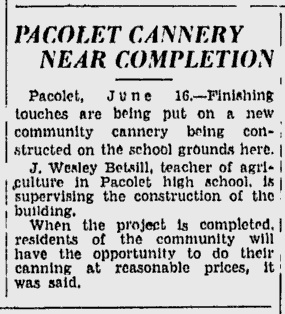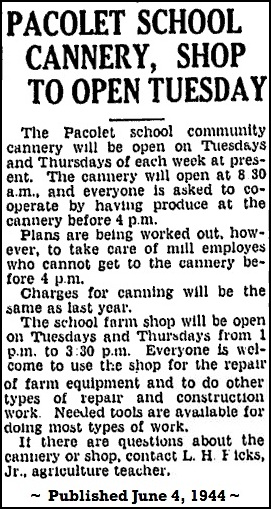The Cannery at Pacolet High School
In the 1930’s, 40’s and 50’s, a great number of people around Pacolet still lived on farms or had big gardens. It was very common for people to preserve or can what they grew. For many people, their canned goods were a big part of their diet throughout the year.
There were two main methods of canning. The first, and least used locally, was putting up the food in real metal cans. This was complex and required special machines to seal the metal tops on the cans. The most common method was to put the food in glass jars and cook and seal it properly.
In the 1930’s, the state of South Carolina had a program to build canneries for people to use at their local high school. One of these was built on the grounds of Pacolet High School. The newspaper articles below are about the Pacolet Cannery.
The cannery itself was a simple, wooden frame building covered on the top and sides by galvanized steel sheeting. It was built behind the gymnasium and beside the baseball field. Beside it, the county or state had built a “Potato House”. As the name implies, this was a place where potatoes could be stored up off the ground in racks. In my memory, I never knew anyone to actually use the building and store potatoes there.
That was not the case with the cannery. I had a memorable, unforgettable encounter with the cannery during my college days. I worked in the summer doing maintenance with District 3. One summer, about 1956 or 1957, my job assignment was to work in the cannery. My main responsibility was to keep the boiler running properly. The boiler produced all of the hot water and steam that was at the heart of the canning process.
Taking care of the boiler meant making sure that it was given enough coal to keep the fire up and making sure the water level in the steam drum was always at the correct level. Keeping the water level correct was no problem. That just required watching the water level gage and opening and closing the water supply valve. Putting in the coal was another matter. When the steam pressure fell, you had to open the door to the fire box and throw in a shovel of coal. You had to be up close and personal with the boiler when adding coal. You can just imagine doing this, in August, in Upstate South Carolina when the temperature outside was 98 degrees and the temperature in the cannery was already 110 degrees before you opened the boiler door. Firing the boiler was not a fun job.
Over time, less and less canning was done and the cannery was finally torn down. One factor in this was probably the spreading use of deep freezers and freezing food rather than canning it.
This web site has been started as a public service to share the story of Pacolet.

